
History of Pirate Surgeons Menu: 1 2 3 4 5 6 7 8 9 10 11 12 Next>>
The History of Sea and Pirate Surgeons, Page 3
Sea-surgeons Enter the Age of Exploration
The role of the sea-surgeon became more important at the beginning of the Age of Exploration. Several technological advances occurred that promoted long exploratory sea voyages from Europe, the most important of which was improved navigational equipment and techniques. Development of the mariner's cross staff and the astrolabe allowed the Portuguese to begin exploring areas out of the sight of land in the 15th century.1 This meant that merchant sailors wounded in the line of duty could not always be brought quickly to shore. Thus began the golden age of sea-surgeons.
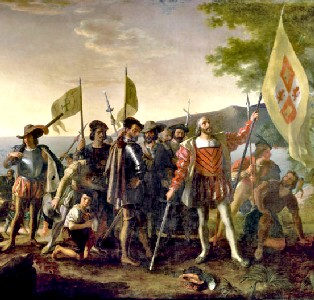
Artist: John Vanderlyn - Landing of Columbus (1847)
No less than American explorer Christopher Columbus carried surgeons on his ships, according to A. J. Aizenstat. Aizenstat lists the surgeons in Columbus's three caravels [ships]: Juan Sanchez in the Santa Maria; Maestre Diego aboard the Pinta and Maestre Alonso on the Niña.2
Columbus' diaries do not tell us anything about what the surgeons needed to do during the voyage, although he does note that on the Island the natives called Saomete (which he named 'Isabella'), "I have no doubt there are trees and herbs here which would be of great value in Spain, as dyeing materials, medicine, spicery, etc., but I am mortified that I have no acquaintance with them."3 One wonders what his surgeons were doing at this point as they may have been of some assistance here. Presumably the surgeons had more to do on later voyages when the crew got into fights with the local Indians, Columbus took ill and the ships encountered violent storms.
Spain was not alone in elevating the importance of ship's surgeons during this era. Historian John Keevil identifies the completion of King Henry VIII's naval flagship Henry Grace à Dieu [Henry Grace of God] as an important hallmark for surgeons on ships in the British Navy. Not only did the King change warfare forever with this new style of cannon-heavy vessel, He also defined "the need to provide mariners with surgeons was accepted as unquestioningly as was the soldiers' medical requirement."4
1 http://en.wikipedia.org/wiki/History_of_navigation; 2 A. J. Aizenstat, Pride of Obsession: The Unusual Life of Christopher Columbus, p. 100; 3 Bartolome de las Casa, Abstract from the Log of Christopher Columbus, http://www.franciscan-archive.org/columbus/opera/excerpts.html, gathered 6/19/12; 4 John J. Keevil, Medicine and the Navy 1200-1900: Volume I – 1200-1649, 1957, p. 60
Sea-surgeons and the Elizabethan Sea Dogs
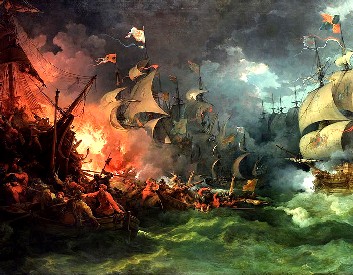
Artist: Philip James de Loutherbourg
Defeat of the Spanish Armada, 8 August 1588 (1796)
When the Spanish Armada sailed in 1588 to depose the heretical Protestant English Queen Elizabeth, it brought with it "eighty-five physicians and surgeons, as well as hospital ships."1 Beset by bad luck, bad weather and forewarning of the Armada via a system of signal beacons along the English and Welsh coasts, the Spaniards were defeated despite their medical preparations. Spain "lost half its ships and three-quarters of its men, over 20,000 Spanish sailors and soldiers had been killed. On the other side the English lost no ships and only 100 men in battle."2 English medicine was not one of the victors of this battle, however. "[O]ver 7,000 English sailors died from diseases such as dysentery and typhus."3
This is not to say that the English didn't have sea-surgeons during the reign of the first Queen Elizabeth. On the contrary, we have record of many sea-surgeons from this time. No less than Captain John Smith, of Jamestown, Virginia colony and Pocahontas fame, explained that the role of the sea-surgeon following a battle was to "look to the wounded, and wind up the slain (with each a weight or bullet at their heads and feet to make them sink, and give them three guns for their funerals)."4
It is here that we can actually begin to talk a bit about the pirate surgeons, for many of the explorers
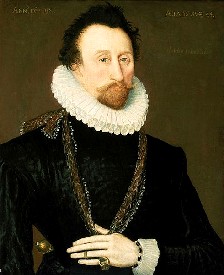
Sir John Hawkins (1581)
committed what were considered acts of piracy, taking Spanish ships at a time when England was not at war with them. Most of these men had been involved in repelling the Spanish Armada and many of the books about them mention sea-surgeons.
John Hawkins made several voyages and a surgeon accompanied him on at least one of them. In the book on his first voyage to the West Indies in 1562, author John Sparke tells us that "Master Hawkins took with him not above 100 men, for fear of sickness and other inconveniences, whereunto men in long voyages are commonly subject [probably referring here mostly to scurvy in addition to other tropical diseases]."5 Whether a surgeon was numbered among those 100 is not revealed, but with the health of his crew was clearly in the forefront of Hawkins' mind, it is probable.
We do know that William Corniels was a barber surgeon who arrived in the Caribbean with the John Hawkins' fleet in 1568. Corniels settled in Guatemala, which proved to be an unfortunate decision. Being an Irish Protestant, he gained the dubious distinction of being the first physician to be judged by the Spanish Inquisition.
1 Zachary Friedenberg, Medicine in the Age of Sail, p.2; 2 Spanish Armada, http://www.historic-uk.com/HistoryUK/HistoryofEngland/Spanish-Armada/, gathered 6/18/12; 3 Ibid; 4 Captain John Smith, "Directions for Taking a Prize" excerpted from The Seaman's Grammar, Voyages of Elizabethan Seamen, edited by Edward John Payne, p. lxxi; 5 Richard Haklyut, Voyages of Elizabethan Seamen, edited by Edward John Payne, p. 7
Francis Drake's Surgeon
Perhaps the most famous Elizabethan Sea Dog was Sir Francis Drake.
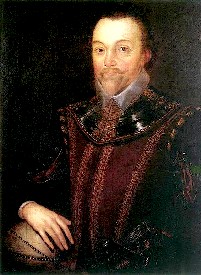
Artist: Marcus Gheeraerts II
Sir Francis Drake (1578)
On his first voyage to the West Indies during a march to the Treasury in Nombre de Dios we are told that
as he was advancing, his strength suddenly failed him, and he fell down speechless. Then it was that his companions perceived a wound in his leg, that he received in entering the town, but had hitherto concealed, lest his men, easily discouraged should make their concern for his life a pretence of returning to their boats. Such, however, had been his loss of blood, as was discovered upon nearer observation, that it had filled the prints of his footsteps; and it appeared scarce credible that, after such effusion, life should remain.1
The men did indeed want to take him back to the ship.
"But Drake, whom cordials had restored to his senses, was the only man who could not be prevailed on to leave the enterprize unfinished. It was to no purpose that they advised him to go on board to have his wound dressed, He well knew how impracticable it was to regain the opportunity when it was once lost, and could easily foresee, that a respite of but a few hours would enable the Spaniards to recover from their consternation.2
The men were persistent, however, and,
they bound up his wound with his scarf, and, partly by force, partly by intreaty, they carried him back to the boats, in which, with what treasure they were able to bring off, they all embarked by break of day. Then taking with them, out of the harbour, a sloop laden with wines, they went to the Bastimento's, an island about a league from the town, where they staid two days, to recover the wounded men who had been hurt in the first rencounter, and to regale themselves with the wines they had taken, and with the fruits that grew in great plenty in the gardens of that island.3
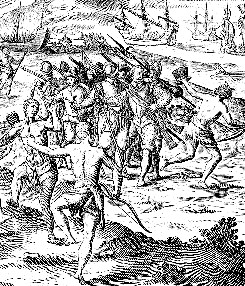
Artist: Theodor de Bry
Drake's Hat Stolen by Indians near Río de la Plata
Sickness dogged Drake's second voyage to the West Indies. Eye-witness Walter Bigges explains that "we were not many dayes at Sea, but there began amongst our people such mortality, as in few dayes there were dead above two or three hundred men. …the sicknesse shewed not his infection wherewith so many were stroken, untill we were departed thence, and then seared our people with extreame hot burning and continuall ague, whereof some very few escaped with life, and yet those for the most part not without great alteration and decay of their wits and strength for a long time after. In some that dyed were plainly shewed the small spotts, which are often found upon those that be infective with the Plague".4
Clearly not the plague, this does sound somewhat like scurvy – an illness caused by a deficiency in Vitamin C. Some of the symptoms include lethargy, pain in the joints (ague) and the formation of dark, blotchy areas in the skin particularly in the legs. Unfortunately, neither the cause nor cure scurvy was well understood at this time, even by the surgeons. In fact, it wouldn't be fully understood for almost two centuries. Fortunately for the crew who survived Drake's ships made there way to St. Kitt's (Christopher's) "wherin we spent some dayes of Christmas, to refresh our sicke People, and to cleanse and ayre our Ships."5
1 David Henry, An Historical Account of All the Voyages Round the World, performed by English Navigators, p. 15; 2Ibid, p. 16; 3Ibid; 4Walter Bigges, A Summary and True Discourse of Sir Francis Drake's West-Indian Voyage, p. 17; 5Ibid, p. 18

